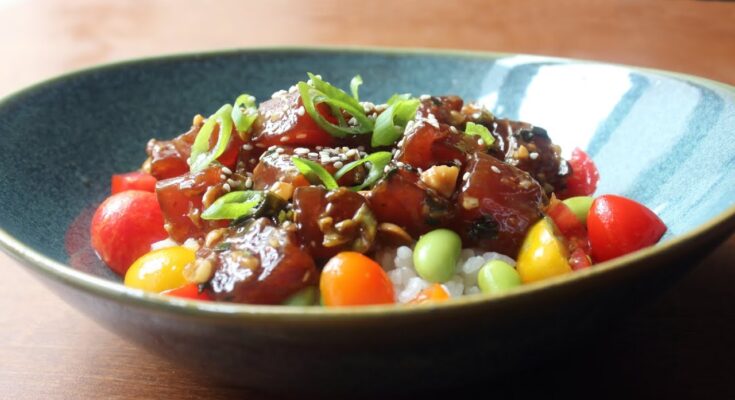Tuna Poke Bowl Recipe: Craving something light, fresh, and bursting with flavor? A tuna poke bowl hits all the right notes. It’s healthy, customizable, and surprisingly easy to make at home. Whether you’re a beginner or an experienced home chef, this step-by-step guide will walk you through everything from picking the freshest tuna to plating a stunning bowl worthy of your Instagram feed.
Let’s dive into the art of creating the perfect tuna poke bowl!
What is a Tuna Poke Bowl?
At its core, a poke bowl is a Hawaiian dish that features diced raw fish—typically tuna—served over rice and topped with various vegetables, sauces, and garnishes. “Poke” (pronounced poh-kay) literally means “to slice” or “cut crosswise into pieces” in Hawaiian. What makes it unique is how it blends Japanese and Hawaiian flavors, creating a dish that’s both light and satisfying.
Imagine a sushi roll deconstructed into a vibrant bowl. That’s what a tuna poke bowl brings to your table—color, texture, flavor, and freshness in every bite. You can think of it as a sushi bowl that allows full creativity, letting you personalize it with all your favorite ingredients.
Whether you’re craving something light after a workout, prepping a quick dinner, or hosting friends, a tuna poke bowl can be made in under 30 minutes. And it’s not just delicious—it’s also loaded with lean protein, healthy fats, and fiber.
Origin and Popularity
The poke bowl originated in Hawaii, where fishermen would season cuts of raw fish with simple ingredients like sea salt, soy sauce, and seaweed. Over time, the dish was influenced by Japanese and other Asian cuisines, leading to the version we love today—with bold sauces, rice bases, and an explosion of toppings.
In recent years, poke bowls have exploded in popularity across the mainland U.S., Australia, and Europe. They’ve become a trendy, go-to meal thanks to their fresh ingredients, customizability, and health appeal. Now, rather than shelling out money at poke restaurants, you can make your own bowl with ingredients from your local grocery store.
Ingredients Needed
Fresh Tuna – The Star of the Dish
The key to a standout poke bowl is, without a doubt, the tuna. You’ll want sushi-grade tuna—typically yellowfin (also known as ahi) or bigeye. Sushi-grade simply means it’s been frozen at ultra-low temperatures to kill any parasites, making it safe to consume raw.
Look for tuna that’s:
- Bright red or pinkish in color
- Glossy and firm, not mushy
- Sold as “sushi-grade” or “sashimi-grade”
You’ll need about 6–8 ounces per person, depending on how protein-packed you want your bowl. Dice it into small cubes just before marinating to keep it fresh.
Rice Base Options
White rice is the classic base, but you can totally mix things up. Some popular rice and grain alternatives include:
- Sushi rice: Short-grain rice seasoned with vinegar, sugar, and salt
- Brown rice: Nutty flavor and more fiber
- Quinoa: A protein-rich, gluten-free option
- Cauliflower rice: Low-carb and keto-friendly
Whichever you choose, the rice should be warm or room temperature. Cold rice can make the dish feel flat, while warm rice enhances the umami flavors of the tuna and sauces.
Toppings and Garnishes
The fun part of poke bowls? The toppings. Go wild or keep it simple. Here are some must-haves and creative additions:
Veggies:
- Diced cucumber
- Shredded carrots
- Edamame
- Avocado slices
- Pickled radish
- Seaweed salad
Crunch:
- Crispy onions
- Toasted sesame seeds
- Crushed macadamia nuts
- Tempura flakes
Spicy kicks:
- Jalapeño slices
- Sriracha drizzle
- Chili flakes
Fresh Herbs:
- Scallions
- Cilantro
- Microgreens
Mix textures—creamy, crunchy, crisp—for the best mouthfeel. You want each bite to be an experience.
Sauce and Marinade Essentials
What ties it all together? The sauce. The marinade for the tuna and the sauce you drizzle over the finished bowl are usually variations of:
- Soy sauce (or tamari for gluten-free)
- Sesame oil
- Rice vinegar
- Sriracha or chili paste
- Lime juice
- Honey or maple syrup for a touch of sweetness
- Garlic and ginger for extra depth
For creaminess, a dollop of spicy mayo or wasabi aioli is pure magic. Want an umami bomb? Add a bit of miso paste or fish sauce to your mix.
Make your sauce in advance so it’s ready to go when your tuna is diced and your rice is cooked.
Choosing the Right Tuna
Sushi-Grade Tuna Explained
“Sushi-grade” isn’t regulated by law, but it’s a term used in the seafood industry to indicate the highest-quality fish, safe for raw consumption. What matters most is how the tuna is handled—from the moment it’s caught to when it’s sold.
Look for:
- Tuna that’s been flash-frozen at -20°C or below
- Transparent labeling at the fish counter or packaging
- A fresh ocean smell—not fishy
If you’re unsure, ask your fishmonger directly or buy from trusted Asian or specialty seafood markets.
Where to Buy Quality Tuna
You can find sushi-grade tuna at:
- Asian grocery stores (like H Mart or Mitsuwa)
- Seafood counters in Whole Foods or other high-end grocers
- Online seafood retailers like Fulton Fish Market or Honolulu Fish Company
Avoid supermarket tuna steaks unless they’re labeled for raw consumption. If in doubt, cook it—poke bowls are still amazing with seared or grilled tuna!
Preparing the Rice Base
Types of Rice to Use
Sushi rice is the traditional base, thanks to its stickiness and slightly sweet flavor. Here’s what works best:
- Short-grain white rice: Holds shape and soaks in flavor
- Brown rice: A healthier, nutty alternative
- Jasmine or basmati rice: Less sticky but still flavorful
Be sure to rinse the rice well before cooking—it removes excess starch and keeps it from becoming gummy.
Cooking and Seasoning Tips
Cook the rice according to your rice cooker or stovetop instructions. Once cooked:
- Let it steam off for 5–10 minutes
- Mix in seasoned rice vinegar (2 tbsp rice vinegar + 1 tbsp sugar + pinch of salt per cup of rice)
- Let it cool slightly before assembling your bowl
A warm rice base helps amplify all the layered flavors in your poke bowl.
Making the Marinade and Sauce
Essential Sauce Ingredients
The marinade is where the magic happens. It’s what turns diced tuna into something savory, flavorful, and utterly crave-worthy. A classic poke marinade usually includes the following ingredients:
- Soy sauce: Adds saltiness and umami
- Sesame oil: Provides a nutty aroma and taste
- Rice vinegar: Brightens the dish with acidity
- Honey or sugar: Balances out the salt and acid
- Fresh garlic and ginger: Boosts complexity
- Chili flakes or sriracha: For a spicy kick
Here’s a basic marinade recipe you can follow:
Simple Poke Marinade:
- 2 tablespoons soy sauce
- 1 tablespoon sesame oil
- 1 tablespoon rice vinegar
- 1 teaspoon honey
- 1 clove garlic, finely minced
- 1 teaspoon grated ginger
- 1/2 teaspoon chili flakes (adjust to taste)
Mix all the ingredients in a bowl and let the tuna sit in the marinade for at least 15–20 minutes. This allows the fish to absorb all the amazing flavors while still maintaining its texture.
Flavor Variations to Try
You can tweak the sauce based on your flavor preferences or dietary needs. Here are some exciting variations:
- Spicy Mayo: Mix mayo with sriracha, a splash of lime, and a dash of sesame oil
- Ponzu Sauce: A citrusy soy sauce variant great for a zesty touch
- Wasabi-Soy Blend: Add wasabi paste for an extra punch
- Miso-Sesame Marinade: Mix miso paste with sesame oil, rice vinegar, and soy sauce
Don’t be afraid to experiment. The poke bowl is forgiving and versatile. You can even split your tuna into two portions and try different marinades for a flavor contrast in the same bowl!
How to Assemble Your Tuna Poke Bowl
Layering for Maximum Flavor
Now comes the fun part—putting it all together. Follow this layering technique for a poke bowl that’s as beautiful as it is delicious:
- Start with the base – Place a generous scoop of your rice or grain into a bowl.
- Add marinated tuna – Spoon the flavorful chunks of tuna over the rice.
- Top with veggies – Add your choice of vegetables (cucumber, avocado, carrots, etc.).
- Add a crunch factor – Sprinkle crispy onions, sesame seeds, or tempura flakes.
- Finish with sauce – Drizzle with more marinade or spicy mayo.
- Garnish like a pro – Top with scallions, cilantro, or a slice of lime for presentation.
Pro Tip: Use a shallow bowl for better visual layering and to keep ingredients evenly spread out.
Presentation Tips
A visually appealing poke bowl isn’t just Instagram-worthy—it enhances the eating experience. Here’s how to make yours pop:
- Use contrasting colors: Red tuna, green avocado, orange carrots, purple cabbage
- Slice veggies thinly and uniformly
- Group ingredients in clusters rather than mixing everything together
- Garnish with microgreens or edible flowers for an elegant touch
Take your time with assembly; it only takes a few extra seconds to make your bowl look like it came straight from a high-end poke bar.
Storage and Meal Prep Tips
How Long Does It Last?
Fresh poke bowls are best enjoyed immediately, especially when using raw tuna. However, you can store leftover components separately in airtight containers:
- Marinated tuna: 1–2 days in the fridge (marinate only what you’ll eat)
- Rice: Up to 3 days refrigerated
- Toppings: Varies by ingredient (avocado browns quickly, pickled items last longer)
Never store a fully assembled poke bowl with raw tuna for more than a few hours. For best texture and taste, keep everything separate and assemble just before eating.
Make-Ahead Prep
Poke bowls can be a meal-prep dream if done right. Here’s how to plan ahead:
- Pre-cook and portion rice into containers
- Chop veggies and store in separate jars or zip-lock bags
- Mix sauce and refrigerate in a small bottle
- Buy tuna the day you plan to eat it for maximum freshness
This way, you can whip up a fresh poke bowl in under 5 minutes during a busy weekday.
Customizing Your Tuna Poke Bowl
Vegan and Vegetarian Alternatives
Not into raw fish? No problem! Here are some delicious swaps:
- Tofu poke: Use firm tofu, cubed and marinated the same way as tuna
- Watermelon poke: Yes, watermelon! It mimics tuna’s texture when marinated
- Beet poke: Roasted or raw beets offer color and earthiness
- Mushroom poke: Shiitake or oyster mushrooms work great when cooked and chilled
These plant-based alternatives still pack tons of flavor and keep the poke bowl spirit alive.
Low-Carb and Gluten-Free Options
Going low-carb or gluten-free? You’ve got choices:
- Swap rice for cauliflower rice or zucchini noodles
- Use tamari or coconut aminos instead of soy sauce
- Top with avocados, nuts, and greens for healthy fats and crunch
Poke bowls are easily adaptable to almost any dietary preference or restriction. The key is to maintain that balance of flavors and textures.
Health Benefits of Tuna Poke Bowls
Nutritional Breakdown
Tuna poke bowls aren’t just tasty—they’re also packed with nutrients that make them a wholesome meal choice. Let’s break down what you get in every bite:
- Lean protein: Tuna is an excellent source of lean protein, helping build muscle, repair tissue, and keep you full longer.
- Omega-3 fatty acids: These healthy fats support heart health, reduce inflammation, and improve brain function.
- Fiber and vitamins: Thanks to the veggies, poke bowls are rich in fiber, vitamin C, potassium, and folate.
- Complex carbs: Brown rice or quinoa provides sustained energy and helps regulate blood sugar levels.
Here’s a quick look at the estimated nutritional profile of a standard tuna poke bowl (based on a 2-cup serving):
| Nutrient | Approximate Amount |
|---|---|
| Calories | 500–600 kcal |
| Protein | 30–35g |
| Carbohydrates | 45–55g |
| Fats | 15–20g |
| Fiber | 5–8g |
This makes poke bowls a balanced meal that fuels your body without weighing you down.
Perfect for Special Diets
Poke bowls are incredibly diet-friendly. Whether you’re paleo, keto, gluten-free, or dairy-free, there’s a way to adapt the recipe:
- Keto: Skip the rice, load up on avocado, tuna, and leafy greens.
- Gluten-free: Use tamari or coconut aminos instead of soy sauce.
- Whole30/Paleo: Stick to whole foods, natural fats, and fresh fish.
With the right substitutions, poke bowls can fit nearly any nutrition plan or health goal.
Common Mistakes to Avoid
Over-Marinating the Tuna
Raw tuna is delicate. If you let it soak in marinade too long—especially acidic ones with vinegar or citrus—it can become mushy or even start “cooking,” similar to ceviche. Aim for 15–30 minutes, max.
Tip: Only marinate what you plan to eat right away. Store leftover tuna separately and mix fresh marinade next time.
Using Poor Quality Fish
This can’t be stressed enough: the quality of your tuna makes or breaks the bowl. Avoid pre-packaged, frozen, or low-grade tuna not labeled safe for raw consumption. If in doubt, ask your fishmonger or switch to seared tuna or tofu.
Overloading with Sauces
It’s tempting to drown your bowl in spicy mayo or soy sauce, but too much sauce can overpower the natural flavors and turn the rice soggy. A light drizzle or mixing a portion of the sauce into the tuna is usually enough.
Not Balancing Textures
A great poke bowl hits all the right textures—creamy avocado, crunchy cucumbers, tender tuna, and sticky rice. Don’t skip out on crunchy elements like sesame seeds or crispy onions. They add an important layer to the overall mouthfeel.
Tips for Hosting a Poke Bowl Party
Poke Bowl Bar Setup
Want to impress your guests without sweating in the kitchen? Set up a poke bowl bar. It’s fun, interactive, and lets everyone build their own bowl just the way they like it.
Here’s how to do it:
- Prep the rice and proteins ahead of time
- Create topping stations with various veggies, fruits, and garnishes
- Offer multiple sauces – soy-based, spicy mayo, citrus ponzu
- Label each ingredient for clarity (especially if guests have dietary restrictions)
- Provide reusable or compostable bowls and utensils
It’s a simple, no-fuss way to entertain, and your guests will love the creativity and freedom to build their perfect poke combo.
Make It a Theme Night
Elevate the vibe by adding some Hawaiian touches—tiki lights, tropical drinks, island music. Offer coconut water, serve fresh pineapple, and maybe even wear a lei. It’s an easy way to bring vacation vibes right to your home.
FAQs about Tuna Poke Bowl Recipe
1. What is a Tuna Poke Bowl?
A Tuna Poke Bowl is a Hawaiian-inspired dish that features diced raw tuna marinated in soy sauce, sesame oil, and other seasonings, served over rice and topped with vegetables, seaweed, and sauces.
2. Is it safe to eat raw tuna in a poke bowl?
Yes—when you use sushi-grade or sashimi-grade tuna from a trusted source. Always ensure it’s kept chilled and consumed fresh to avoid foodborne illness.
3. Can I make a Tuna Poke Bowl ahead of time?
You can prep the toppings and rice ahead, but for best taste and safety, marinate the tuna shortly before serving and keep it refrigerated until ready.
4. What type of rice is best for poke bowls?
Short-grain white rice or sushi rice is ideal for poke bowls due to its sticky texture, but brown rice or quinoa are great alternatives for a healthier twist.
5. Can I customize the toppings?
Absolutely! Popular additions include avocado, cucumber, edamame, shredded carrots, mango, pickled ginger, and spicy mayo.
6. How long can tuna poke stay in the fridge?
Consume marinated tuna within 24 hours. If stored properly in an airtight container and refrigerated, it remains safe but may lose texture and flavor after that.
7. Can I use frozen tuna?
Yes—thaw sushi-grade frozen tuna in the refrigerator overnight. Avoid using previously frozen fish that’s not labeled safe for raw consumption.
Conclusion
Plus, the beauty of the poke bowl lies in its flexibility. Whether you want something spicy, sweet, crunchy, light, or hearty, you can create it in a poke bowl. And it doesn’t stop with tuna—swap in salmon, tofu, or even cooked shrimp to explore endless variations.
So next time you’re looking for a quick yet impressive meal, skip the takeout and whip up a homemade tuna poke bowl. It’s easy, it’s healthy, and it’s guaranteed to satisfy.



